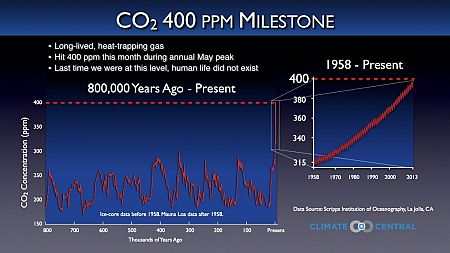Ahead of U.N. climate talks next week, a new report warns of "severe ecological and economic disruptions" without more drastic moves to cut emissions. Jessica Corbett reports.
'As far as direct and proxy observations can tell, such abrupt changes in the atmospheric levels of CO2 have never before been seen' (Quote from 2016 'Greenhouse Gas Bulletin', graphs via climatecentral.org)
AHEAD OF the COP23 climate negotiations in Bonn, Germany, next week, an annual bulletin released on Monday revealed that last year, the average global concentration of carbon dioxide surged at a record breaking pace, to the highest level in approximately 3 million years, renewing scientists' concerns that more action is needed to reduce greenhouse gas emissions.
"This should set alarm bells ringing in the corridors of power," Dave Reay, a professor of carbon management at the University of Edinburgh, who was not involved with the research, told the Guardian. "We know that, as climate change intensifies, the ability of the land and oceans to mop up our carbon emissions will weaken."
Reay added:
"There's still time to steer these emissions down and so keep some control, but if we wait too long humankind will become a passenger on a one-way street to dangerous climate change."
The Greenhouse Gas Bulletin (PDF), published by the United Nations World Meteorological Organization's (WMO) "Global Atmosphere Watch" program, found that globally averaged CO2 concentrations increased from 400 parts per million (ppm) in 2015 to 403.3 ppm last year.
Scientists have reliable data on carbon dioxide concentration spanning approximately 800,000 years, and researchers estimate the last time the planet had a comparable concentration of carbon dioxide was 3 to 5 million years ago, during the Pliocene epoch, when the global temperature was up to 3°C warmer and due to melting ice sheets, sea level was about 66 feet higher than it is today.
'The rate of increase of atmospheric CO2 over the past 70 years is nearly 100 times larger than that at the end of the last ice age.' ~ 2016 Greenhouse Gas Bulletin
The Bulletin attributes the increase in CO2 levels to the El Niño event and greenhouse gas emissions from human activities, including
'... growing population, intensified agricultural practices, increases in land use and deforestation, industrialization, and associated energy use from fossil fuel sources ... [since the] ... industrial era, beginning in 1750.'
While emissions represent the full amount of carbon dioxide released into the atmosphere, the measured concentrations focus on what remains in the atmosphere 'after the complex system of interactions between the atmosphere, biosphere, cryosphere, and the oceans.' As carbon sinks, the oceans and biosphere each take up about a quarter of total CO2 emissions.
The Bulletin warns that today's global CO2 concentrations, which are now 145 per cent of levels before 1750, will likely have a notable impact on global climate systems and cause 'severe ecological and economic disruptions'.
"CO2 remains in the atmosphere for hundreds of years and in the oceans for even longer. The laws of physics mean that we face a much hotter, more extreme climate in the future," said WMO Secretary-General Petteri Taalas.
Taalas added:
'Without rapid cuts in CO2 and other greenhouse gas emissions, we will be heading for dangerous temperature increases by the end of this century, well above the target set by the Paris climate change agreement. Future generations will inherit a much more inhospitable planet.'
'The longer we wait to implement the Paris Agreement, the greater the commitment and the more drastic (and expensive) the required future emission reductions will need to be to keep climate change within critical limits,' the Bulletin notes, echoing growing concerns about the economic costs of climate change, which were the focus of a Government Accountability Office report released last week.
The Bulletin comes ahead of a separate U.N. Environment Emissions Gap Report, which will be released Tuesday and analyses the projected effectiveness of various nations' policies to reduce greenhouse gas emissions through 2030. The two reports will serve as "a scientific base for decision-making" at the COP23 climate talks, according to the WMO.
"The numbers don't lie," said Erik Solheim, head of U.N. Environment:
"We are still emitting far too much and this needs to be reversed. The last few years have seen enormous uptake of renewable energy, but we must now redouble our efforts to ensure these new low-carbon technologies are able to thrive."
Solheim concluded:
"We have many of the solutions already to address this challenge. What we need now is global political will and a new sense of urgency."
This article was originally published on Common Dreams and has been republished under a Creative Commons licence.
Monthly Donation
Single Donation
We'll probably be living in a world 3C warmer than today by end century -UN report. Unless we #ActOnClimate! https://t.co/ZUzFv1WSc4
— Tim Pearson (@tmpear) October 31, 2017
Take action. Subscribe to IA.













